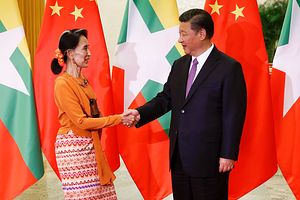A few steps away from Yangon’s historic Bogyoke museum, which is dedicated to the father of State Counselor Aung San Suu Kyi, a newly renovated building stood ready for a soft opening. On August 6, Song Tao, head of the International Liaison Department of the Central Committee of the Communist Party of China (CPC) proudly opened the “Daw Khin Kyi Women’s Hospital,” named after the state counselor’s mother.
Later in that afternoon, Song visited U Tin Oo, chairman of the ruling National League for Democracy (NLD), who has been hospitalized since May. He also met with Aung San Suu Kyi herself. This was not Song’s first meeting with a legendary political figure in Myanmar; during his last visit, in August 2016, he met with former dictator Than Shwe.
The meeting, and the donation of the new hospital, implies that CPC is ready for a deeper party-to-party relationship with Myanmar’s NLD. After years of freezing out Suu Kyi’s party in favor of the country’s military rulers, China is now courting its lost friend again.
The China Friendship Foundation for Peace and Development (CFFPD), a Beijing-supported government-organized nongovernmental organization, has taken bold steps to warm up relations. Although a new kid in town, CFFPD associates with high profiles like the Yangon regional government and the Union of Myanmar Federation of Chambers of Commerce and Industry (UNFCCI). Unlike its other western counterparts, CFFPD implements projects across Myanmar and, despite its low profile, is carving out the next chapter for China-Myanmar relations.
During the previous Thein Sein administration, the suspension of the Myitsone dam (a major Chinese investment project), the ballet with the United States and European Union, and a challenge to the hegemony of Beijing along the border with the Western-led peace process combined to cool down the previous two decades of warm relations. In response to this, Beijing gave a shot in the arm to the ethnic armed groups (EAGs) along the border, creating the division of EAGs into northern and southern blocs, including the formation of a new ethnic alliance, the Northern Alliance.
Today, the U.S. seems to be in retreat from Southeast Asia under the Trump administration and Naypyidaw’s political approach to the peace process (through the 21st Century Panglong Peace Conference) has helped undo some of the damage to China-Myanmar relations. After a request from Naypyidaw, Beijing mediates, insists upon, and logistically supports the Northern Alliance to participate in the NLD government’s peace dialogue. Beijing had laid its cards on the table as a game changer in the Myanmar peace process.
Beijing has won the hearts of Naypyidaw; however, wires were crossed with the Myanmar military (Tatmadaw) in the process. China’s dealing with the EAGs, which the Tatmadaw considered non-dialogue partners, even while strengthening troops and joint drills along the Myanmar border has irritated the military. Plus, due to 2015 Kokang crisis, Beijing’s engagement with the Myanmar National Democratic Alliance (MNDAA) increased anti-Chinese sentiments among the Tatmadaw’s officers. Beijing’s relationship with Myanmar thus has two fronts, Naypyidaw (the government, currently controlled by the NLD) and the Tatmadaw (the military).
Tellingly, the Northern Alliance issued a public statement giving its support to China’s Belt and Road Initiative, hinting that Beijing would use its leverage on the peace process to secure economic interests. Although Naypyidaw has not taken an official position on the BRI, the Kyaukpyu port project is on a roll. Kyaukpyu, which would provide direct access to the Indian Ocean with a link to Kunming in China, is of vital economic interest to Beijing. With the fate of the Myitsone dam project to be decided soon, bringing in Kyaukpyu and a proposal to import electricity from China is not coincidental. If the government elects to terminate the Myitsone dam project, Naypyidaw may offset with the Kyaukpyu–Kunming corridor and the power grid. Yet concerns remain in Myanmar. The lack of a tendering process or transparency over imports of 2,000 Chinese buses (worth $100 million) by the Yangon regional government placed a big question mark over Naypyidaw’s favorable position toward such deals with Beijing.
Meanwhile, Myanmar’s military continues to seek alternatives. The recent official visit of the Tatmadaw’s commander in chief to both India and Japan balanced Beijing’s influence in Naypyidaw. India is providing the Tatmadaw with training in peacekeeping and endorsed Myanmar’s bid to join UN peacekeeping operations. The Tatmadaw has also endorsed India’s Act East policy and committed to strengthening the relationship with Japan. This move will support the Japanese “Indian Ocean Economy” and the Japanese-India partnership to invest in Myanmar and ports along the Indian Ocean, aimed at countering China’s hegemony.
It’s too early to conclude whether Beijing has successfully turned the clock back. The reaction from the Naypyidaw is relatively positive, and the U.S. retraction and economic downturn has created a window of opportunity for Beijing to engage. However, Tatmadaw’s policy on looking west and strengthening ties with Western countries may counterbalance China’s efforts. Courting Myanmar works to an extent, but China may have to accept that the relationship may never be the same again.
Amara Thiha is the Asia Foundation’s 2017 William P Fuller Fellow in Conflict Resolution and a visiting fellow at the Stimson Center. He previously worked in the Joint Ceasefire Monitoring Committee and the Myanmar Peace Center. The views and opinions expressed here do not necessarily reflect the policies or positions of the Asia Foundation and Stimson Center.

































